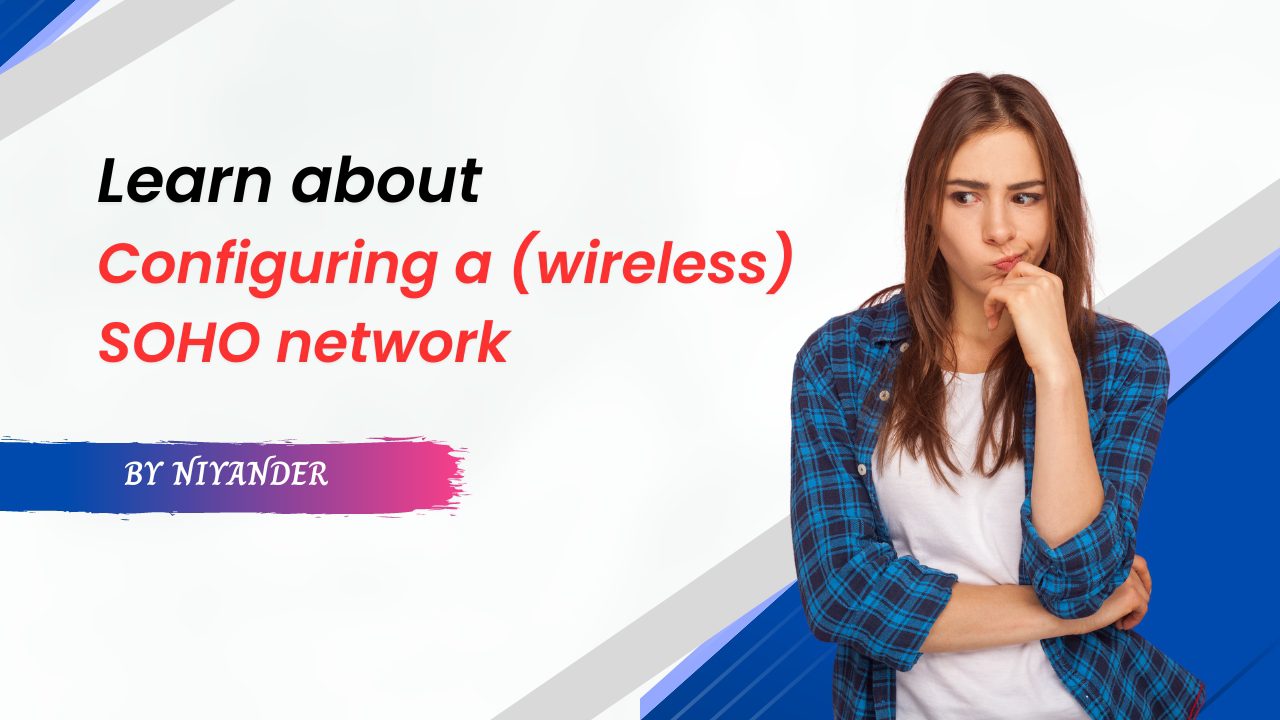Configuring a wireless SOHO network
Welcome to “Configuring a wireless SOHO network.” After reading this article, you will be able to:
Also visit: What is a SOHO network
- List the features of a SOHO wireless network.
- Describe how to configure a WAP, SSID, security, and encryption.
- Explain how to test and troubleshoot a SOHO wireless network.
Configuring a wireless SOHO network
A small office / home office, or SOHO, wireless network is a wireless local area network, or WLAN, that serves a small physical space with a small number of employees or home users. A SOHO wireless network can be configured with the help of a central wireless access point, or WAP, which can cover a range of wireless devices within a small office or home. SOHO networks often use email, website, and cloud subscription services since maintenance and reliability are included. Basic equipment maintenance is easy since there are only a handful of devices and cables to consider. Some common broadband types that enable network connection include: Dynamic Host Configuration Protocol, or DHCP.
DHCP is the most common broadband type. It is used in cable modem connections. PPPoE, or Point-to-Point Protocol over Ethernet, is used in DSL connections in areas that don’t have newer options. Static IP is more common in business. DHCP is the easiest broadband type to use. Internet Service Providers can provide other options if needed. Wireless networks can be set up to be either open or encrypted. Open networks are popular in public spaces because they don’t require a password. However, they are easily exploited because anyone can join. Encrypted networks require a password before users can connect.
There are different types of wifi encryption,
the strongest being WPA2.
A captive portal is a web page popup that authenticates users who try to log in to wifi in places like apartment houses, hotel rooms, and small business centers. However, a captive portal is not a secure connection. On the rear of a typical wireless router, you’ll see several connections: A power input jack One or more wired Ethernet jacks for wired connections. These may include a jack for broadband connection, often labeled “WAN” or “Internet”.
A USB port which lets you connect a printer or external hard drive for sharing on the network And a wifi on/off button, which allows you to easily enable or disable a wireless network To manage a router, you must find its default IP address:
- First, type “cmd” into the Windows search bar to open the command prompt.
- Then, type “ipconfig” in the command prompt window to see IP information for your network.
- Next, copy the Default Gateway IP address, paste it into a web browser, and hit enter. A login will appear. The default router username and password are usually “Admin.” Change these during setup to protect the network. Whenever a change is made, “Save Settings” must be clicked. After setup, if you cannot access the Web, the router is not connected.
- This is usually caused by choosing the wrong broadband connection type for your service.
- A service set identifier, or SSID, is the name of a wireless network. This name is chosen during the setup of a wireless network. It’s a good idea to choose a unique name to distinguish your router from any neighboring wireless routers nearby.
- Each country determines the band usage and the available 802.11 Modes. The supported modes for the 2.4 GHz band are 802.11 (b/g/n). And, the supported modes for the 5 GHz band are 802.11 (a/n/ac). Every router has a default option which supports all types. If you are not sure which modes are supported, select the default one. Most wireless network users will select one of the common forms of secure encryption:
Wired Equivalent Privacy, or WEP, was the first security protocol developed. It was retired due to security flaws. It is only in use now when equipment is old or not updated. Wireless Protected Access, or WPA, is stronger than WEP, and supports a wide variety of devices.
WPA2 is even stronger and is supported on newer wireless devices. WPA2 is the most common and most secure. When you configure your encryption, select the WPA2 security mode. Set your “Pre-Shared Key”. This is your WPA password. It must be 8 to 63 characters long. Choose a longer, harder to guess key for stronger security. Once the router is configured your wireless network is ready. Users will see it among the available wireless networks when they click the wifi icon, located at bottom-right of PC screens and in the drop-down menu of mobile devices. Test network performance and Internet connectivity on each wireless device in the vicinity of the WAP. If needed, troubleshoot performance issues like network lags, glitches, or blocked access with the following actions: First, check the router configuration settings. Next, run security tools, check for updates, restart devices, run diagnostics, reboot router or modem, and finally, check your equipment for damage.
Summary
In this article, you learned that: A SOHO wireless network is configured with a central Wireless Access Point (WAP) to cover all wireless devices within a small office or home. DHCP is the most common broadband type, over PPPoE and Static IP. The ipconfig tool lists the IP address of a host on a network, and the IP address of its assigned default gateway. SSID is the name of a network and can be changed in the router settings. WPA2 is the best encryption choice because it is the strongest.

